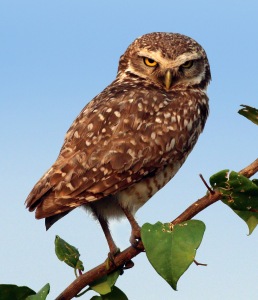
Burrowing Owl (source: Wikipedia)
Did you know that Burrowing Owls are immune to bubonic plague? Burrowing Owls are immune to bubonic plague. Yes, folks, bubonic plague is still around. It’s endemic to rodents in, among other places, the southwestern US and Africa. And, yes, people still die from it.
Other fun facts about Burrowing Owls include that they’re diurnal (active during the day) and that they can use their long legs to run after their prey. Seriously.
The word “burrowing” comes from the word “burrow”…which is of unknown origins. Maybe it’s related to “borough,” which means “a stronghold.” Or something.
“Owl” can be traced back to the Old English ulae and is related to the Dutch uil, German Eule, Old Norse ugla, and so forth, all coming from the hooting sound that owls make. The Latin word ululare “to hoot” comes from the same onomatopoeic roots and is where we get the word “to ululate.”
Athene comes from the Greek goddess Athena, patroness of wisdom, war, and much else besides. Her symbol was an owl, as owls are often associated with wisdom. The internet has plenty of speculation as to why owls are often cross-culturally associated with wisdom, but none are particularly compelling, so I’ll leave us here.
 Famous “owl of Athena” ancient Greek coin.
Famous “owl of Athena” ancient Greek coin.
Finally, the word “cunicularia” means “miner” or “burrower” in Latin. Cf Formica cunicularia, the “mining ant.” (I dunno, it’s an ant. Apparently it’s found on the Isle of Wight. I do birds, not insects.)